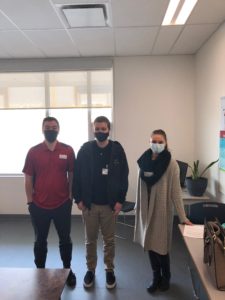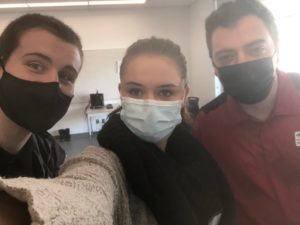As the great Albus Dumbledore once said to Harry Potter in his journey: “It is not our abilities that show who we truly are, but it is our choices, Harry” (J.K. Rowling). This resonates as an attribute to those who decide to give rather than receive, as an act of compassion for their students. There is no doubt that coming into the program, there were some concerns of my limitations and my introverted personality that was going to hold me back. However, after days and nights of working together with my peers, and much consideration of why I wanted to teach to begin with, I have found an unequivocal sense of gravity towards the vocation side of teaching, making a difference in the lives of my students. This can be done in a variety of ways, socially, emotionally, academically, and many others that have risen to the surface in the education program, not because I am by any stretch the most academically gifted, but because of the choices I have come to learn through action with any given learning group.
“No profit grows where is no pleasure ta’en” (Shakespeare, The Taming of the Shrew). As many can relate, the never-ending list of my struggles within my post-secondary education has shaped the way I am today. Although extremely difficult finding out that I had to learn from scratch how to write and format a paper, tweaking my writing was a blessing in disguise. A few mistakes, and admittedly a few barely passing grades, morphed my empathy as an educator by understanding “the process” that many of us feel in our education. Much like the first people’s principle learning #7 (learning takes patience and time), I was able to work on my ability not just to write, but how to understand a student’s struggles—and most importantly how to overcome them with patience—with best possible way to avert that. In this help with my students, there are satisfying moments, nevertheless, that make teaching such a reward.

There is no doubt that an English teacher of mine has inspired me to communicate the same message, art as a form of identity and expression. Much like this English class, exploring the scaffolding of character development in Macbeth, the education program has provided that opportunity but with even more room for improvement. We have built applicable knowledge to the real world in understanding the processes of improvement over time, specifically using character foil—a character dynamic between two polar opposite characters—as noticed through my observation practicum. To digress for a moment, I had one of the most memorable conversation with my pod in this practicum, which I am going to quite miss the lunch time engagement with my peers. Now providing this analysis of a character, it allowed me to see an entire world of learning beyond simple words on the page, yet nonetheless stemming from that written prose. I was able to learn how learning can be explored through text, while also being included in acting out the roles of the character in the play. Learning about the world through text and inclusivity are certainly things that go hand in hand, yet I have only reached the tip of the iceberg with these notions.


Having to adjust to an online way of learning, I was able to align myself with an educator’s perspective by gaining a consistent platform of expression and speech. The discussions of bias, how to recognize one’s own bias in a lesson, has nevertheless aided me in my understanding of making a lesson. While the learning to adjust from online to in school on a weekly basis was also a provoking way to expand my thinking of EDUC 394, and how to apply it to practice. The idea of learning progressions was key, to my liking was done through English, specifically in seeing how different grades were taught in terms of content and interaction. Juxtaposing EDUC 394: Theory in Practice and EDUC 390: Observational Practicum is essential to grasp the full level of my awareness and thought provoking during block one. While one class had me think about curriculum through a website and with peers, the other challenged me to observe how that curriculum was directly tied to practice—and it was. Just seeing the flexibility of some graphic novel lessons, how they are created, structured, formatted, and told in the flow of a story, was essential to see the world of learning that can be applied to an English classroom I have one day. Not only did I see flexibility firsthand in the curriculum within my learning group of learning progressions, but I was also able to see the choice and passion students were ‘literally’ handed to them at the availability of different stories of a graphic novel. Ultimately, even though these two courses were at the forefront of how my thinking was provoked, it seemingly somehow always came back to the first people’s principles of learning #7, learning takes patience and time.


Patience and Time
Even before entering my first opportunity to teach that I can learn to be taught what to do to teach with my students, but there is simply no coaching teacher that can tell me HOW to teach. Teacher candidates can fall into something that often mirrors the coaching teacher/mentor they have been placed with. Figuring out a style that works for me, as well as being authentic for my students, is piece that I will always take away within the education program. Students like to learn and be challenged in ways that expand their thinking to a way that fits them, so teachers should face no different challenge in their learning journeys as well.
Although I am often a “hoverer”, my innate ability to connect with students and develop relationships is a positive brought from these past experiences. Although I thoroughly have enjoyed conversing with my peers this block, I am quite distinctly classified as an outgoing introvert who feels comfortable with students and scared of the adults. I believe this can be a positive in terms of how I connect to students, bringing that to the table with other teachers I work with. With this comes the ability to adapt to an already flexible, and emerging, curriculum to ultimately adjust whatever needs my students may have.
“Not all those who wander are lost” (J.R.R. Tolkien). I often wonder about the simple act of wondering. This quote sums up for me the best possible notion of how to proceed in the profession, which gives me the freedom to not stop the continuous process of learning. Amidst the first block, a teacher once gave me the advice, to answer my question, that it is not about how you navigate through learning and teaching, but it is about the complexity of balancing the two of these notions simultaneously. And so, Tolkien’s most widely known quote about those who wander could not simply be more accurate in my case as a future educator, learning to always learn.
A learning provocation, further than the thoughts expressed above, is one that considers all abilities, personalities, and interests of students. Whether or not my students are strong with the content, the question remains of how do I get my students to engage and genuinely be interested in the topic through inclusivity and text. Can I make a difference in a youth’s life, academically, socially, emotionally, even though there are clear cases where a teacher admitting that they must do the best they can and live with the result? Thus, does navigating through student needs, teacher needs, learning, listening, teaching, all go hand in hand simultaneously and at what point does the teacher become the master? My answers fall under the metaphor of not stopping at the finish line, but continuing to find a new finish line to cross.
Leave a Reply